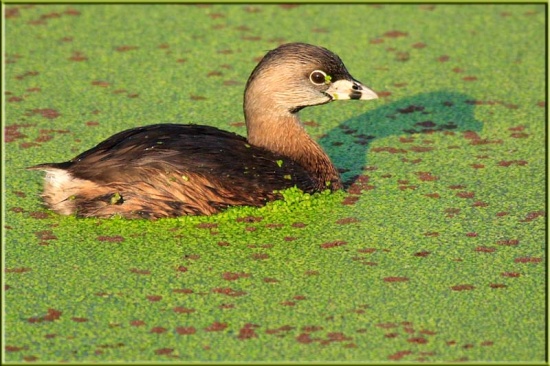m (taxon, minor format issues) |
BigRedBirder (talk | contribs) |
||
| Line 2: | Line 2: | ||
[[Image:Pied-billed_Grebe.jpg|thumb|550px|right|Photo by raulqc.<br/>Photographed: Green Cay, [[Florida]], USA.]] | [[Image:Pied-billed_Grebe.jpg|thumb|550px|right|Photo by raulqc.<br/>Photographed: Green Cay, [[Florida]], USA.]] | ||
==Identification== | ==Identification== | ||
| − | Dark gray-brown above | + | L. 30-38cm<br/> |
| + | Ws. 59cm | ||
| + | *Dark gray-brown above | ||
| + | *Paler gray-brown, tinged rufous, on breast and flanks | ||
| + | *Belly and fluffy undertail coverts white | ||
| + | *Head and hindneck dark gray-brown or blackish | ||
| + | **Sides of head paler and tinged rufous | ||
| + | *Black chin and throat | ||
| + | *Short, thick bill | ||
| + | **White with black central band | ||
| + | |||
| + | |||
==Distribution== | ==Distribution== | ||
| Line 13: | Line 24: | ||
==Behaviour== | ==Behaviour== | ||
| + | ====Diet==== | ||
Its diet includes small fish, frogs and tadpoles and aquatic invertebrates. | Its diet includes small fish, frogs and tadpoles and aquatic invertebrates. | ||
| − | + | ====Breeding==== | |
It builds its nest as a heap of floating vegetation on edge of reedbeds or other marginal vegetation, sometimes on the bottom in shallow water. 4-7 whitish, tinged bluish or buff eggs are laid which are incubated by both sexes for 23-24 days. Young tended by both sexes. Single or double-brooded. | It builds its nest as a heap of floating vegetation on edge of reedbeds or other marginal vegetation, sometimes on the bottom in shallow water. 4-7 whitish, tinged bluish or buff eggs are laid which are incubated by both sexes for 23-24 days. Young tended by both sexes. Single or double-brooded. | ||
Revision as of 15:20, 29 January 2008
- Podilymbus podiceps
Identification
L. 30-38cm
Ws. 59cm
- Dark gray-brown above
- Paler gray-brown, tinged rufous, on breast and flanks
- Belly and fluffy undertail coverts white
- Head and hindneck dark gray-brown or blackish
- Sides of head paler and tinged rufous
- Black chin and throat
- Short, thick bill
- White with black central band
Distribution
United States, Canada, Mexico, the West Indies, Colombia, Venezuela, and Argentina.
Taxonomy
Three subspecies recognised varying slightly in colour of upperparts, overall size, bill size and extent of bill-band and chin patch. Nominate race occurs in North America and winters south to Panama and Cuba, antillarum breeds in the West Indies and antarcticus in South America.
Habitat
Freshwater, sometimes estuaries but very rarely on the sea.
Behaviour
Diet
Its diet includes small fish, frogs and tadpoles and aquatic invertebrates.
Breeding
It builds its nest as a heap of floating vegetation on edge of reedbeds or other marginal vegetation, sometimes on the bottom in shallow water. 4-7 whitish, tinged bluish or buff eggs are laid which are incubated by both sexes for 23-24 days. Young tended by both sexes. Single or double-brooded.




